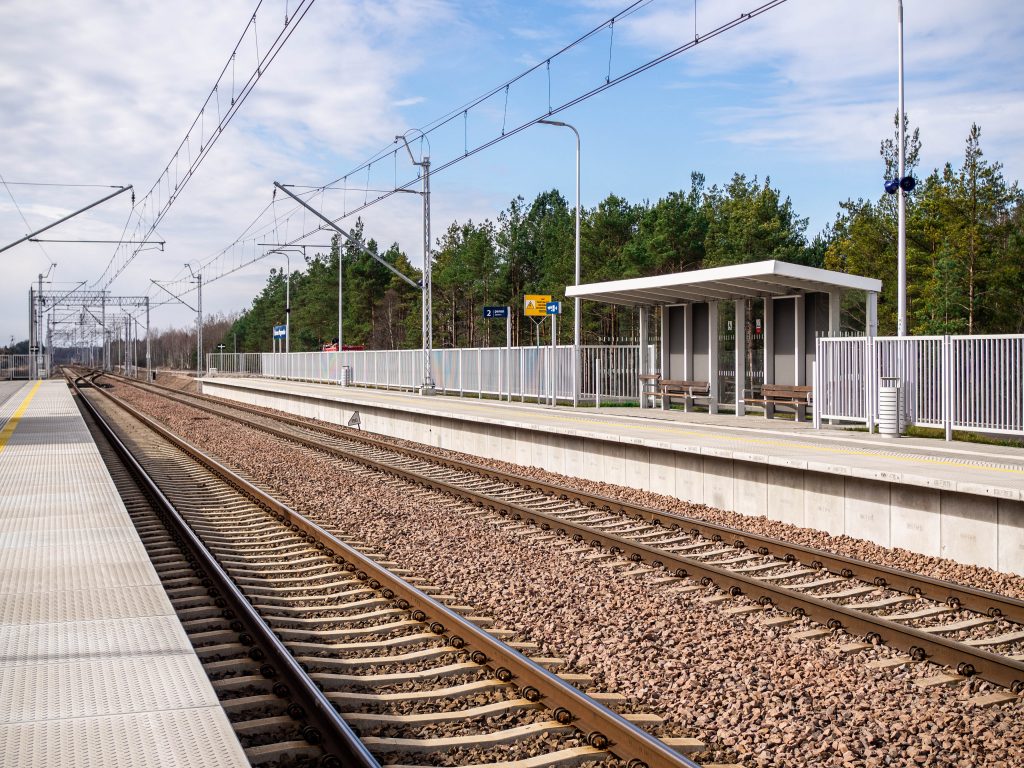The Connecting Europe Express visiting Poland had a chance to benefit from the effects of the investments carried out by PKP Polskie Linie Kolejowe S.A. and co-funded by the EU “Connecting Europe” instrument. Especially those realised on the Polish section of the Rail Baltica international line.
The visit of the CEE train in Poland was part of the celebration of the European Year of Rail 2021- an initiative of the European Commission that promotes rail as a safe and environmentally friendly mean of transport. Thanks to the modernization of Polish railways, our passengers are gaining better and better travel opportunities.
The train set off from Lisbon on September 2 and after visiting several EU countries reached Poland on 19th September. It had special stops in Warsaw, Gdansk where was a part of an exhibition on TRAKO railway fair, Bialystok and Krakow. The train had a chance to run over the Polish section of the Rail Baltica line and stopped at the newly modernized station of Bialystok.
Rail Baltica in Poland
The modernization of the Rail Baltica railway line is one of the most important railway investments currently realised in Poland by PKP Polskie Linie Kolejowe S.A. It is part of the trans-European corridor that will connect Germany, Poland, Lithuania, Latvia, Estonia and in the future also Finland. In Poland, its construction covers approx. 390 km of railway lines from Warsaw through Czyzew-Bialystok and Elk towards Trakiszki on the Polish – Lithuanian border.
The Polish section, which is the E75 line, is part of the Rail Baltica international railway corridor. It is one of the EU’s 8 flagship cross-border transport projects and is also a part of the North Sea-Baltic Corridor of the TEN-T core network as well as the North Sea-Baltic Rail Freight Corridor RFC 8 route.
Benefits for Poland and Europe
The establishment of a modern international railway line will allow to increase the number of connections, improve safety and shorten travel times. Passengers will enjoy renovated, comfortable stops and stations with convenient, modern platforms adopted to the needs of people with reduced mobility and clear information.
The modernization of the Polish section of the Rail Baltica line will bring benefits not only to passengers but also to entrepreneurs and drivers. Railways in Poland will become an attractive, ecological alternative to road transport, including freight. As a result, it will be possible to reduce traffic congestions on local roads and reduce CO2 emissions. Improving the transport of goods will also increase the economic and investment attractiveness of the regions. Thanks to the modernized bridges, viaducts and railroad crossings safety in rail and road traffic will be improved.
Construction works realised by PKP PLK S.A.
We divided the modernization of the Rail Baltica line in Poland into five stages. In 2015, the main works on the Warsaw Rembertow – Tluszcz (Sadowne) route were completed. The investment in this section included the construction or reconstruction of 4 stations, 14 railway stops and replacement of 60 kilometres of railway tracks In addition, many engineering facilities have been modernized, including 8 bridges and 24 rail-road crossings.
In 2019, PKP PLK completed the works on the second stage of the project. As part of the modernization of the Sadowne – Czyżew route, 2 stations, 4 stops and 36 km of tracks were rebuilt. Thanks to the construction of a new bridge and a second track on the Bug River, train traffic has been improved. The Local Traffic Control Centre in Małkinia was built, ensuring safety and supervision over running trains.
At the Warsaw-Czyzew section, the safe two-level crossings are currently under construction – mainly viaducts. PKP PLK plans to build 12 such facilities, of which 4 are already completed.
Works are progressing….
The Czyżew – Białystok section, located in the Podlasie Region, is 71 km long. There are plans to modernize 6 stations, 12 stops and 10 railway bridges, including the largest, almost 200-meter-long bridge over the Narew River located in the unique Narew National Park. Bialystok, the largest city in north-eastern Poland, will also benefit from the investment. The station will be modernised, and an additional railway stop will be built to facilitate everyday travel. The Local Railway Traffic Control Centre will ensure the safe running of trains on the Podlasie section of the Rail Baltica route.
In August 2021, PKP Polskie Linie Kolejowe S.A. signed a contract for the reconstruction of the Elk station and the railway network in the city. This is the first stage of works on the section between the cities of Bialystok and Elk. Passengers will gain a comfortable station where all platforms will be raised and widened, which will greatly facilitate access to the trains. There will be elevators on each platform which will facilitate railway access for people with reduced mobility. Communication at the station will be improved by a new passage. Thanks to the modernization of the Elk Towarowy station, the transport of goods will be improved. The station will be able to accept trains of 740 m length.
The final stage of the construction of the Polish part of the international Rail Baltica route will be the modernization of the 94 km long section from Elk to Trakiszki near the border with Lithuania. PKP PLK is planning to sign a contract for the design documentation, which is to be ready in 2023.
Works on the Polish section of the Rail Baltica route are co-financed by the CEF “Connecting Europe” instrument.
If you want to learn more about the Rail Baltica line :
- Watch the video : https://youtu.be/H86wEf0TTyI
- And visit the website: https://www.rail-baltica.pl/



